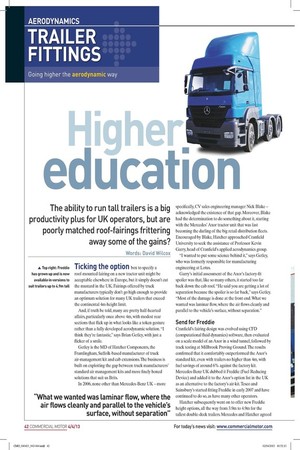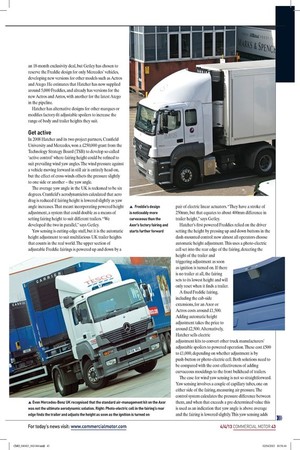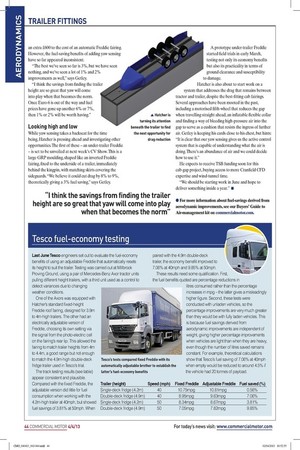Higher. education The ability to run tall trailers is a
Page 29

Page 30

Page 31

If you've noticed an error in this article please click here to report it so we can fix it.
big productivity plus for UK operators, but are poorly matched roof-fairings frittering away some of the gains?
Words: David Wilcox roof-mounted fairing on a new tractor unit might be acceptable elsewhere in Europe, but it simply doesn't cut the mustard in the UK. Fairings offered by truck manufacturers typically don't go high enough to provide an optimum solution for many UK trailers that exceed the continental 4m-height limit.
And, if truth be told, many are pretty half-hearted affairs, particularly once above 4m, with modest rear sections that flick up in what looks like a token gesture rather than a fully developed aerodynamic solution. "I think they're fantastic," says Brian Getley, with just a flicker of a smile.
Getley is the MD of Hatcher Components, the Framlingham, Suffolk-based manufacturer of truck air-management kit and cab extensions. The business is built on exploiting the gap between truck manufacturers' standard air management kits and more finely honed solutions that suit us Brits.
In 2006, none other than Mercedes-Benz UK — more A Top right: Freddie Ticking the option box to specify a has grown up and is now specifically, CV sales engineering manager Nick Blake — acknowledged the existence of that gap. Moreover, Blake had the determination to do something about it, starting with the Mercedes' Axor tractor unit that was fast becoming the darling of the big retail distribution fleets. Encouraged by Blake, Hatcher approached Cranfield University to seek the assistance of Professor Kevin Garry, head of Cranfield's applied aerodynamics group.
"I wanted to put some science behind it," says Getley, who was formerly responsible for manufacturing engineering at Lotus.
Garry's initial assessment of the Axor's factory-fit spoiler was that, like so many others, it started too far back down the cab roof. "He said you are getting a lot of separation because the spoiler is so far back," says Getley. "Most of the damage is done at the front end. What we wanted was laminar flow, where the air flows cleanly and parallel to the vehicle's surface, without separation."
Send for Freddie Cranfield's fairing design was evolved using CFD (computational fluid dynamics) software, then evaluated on a scale model of an Axor in a wind tunnel, followed by track testing at Millbrook Proving Ground. The results confirmed that it comfortably outperformed the Axor's standard kit, even with trailers no higher than 4m, with fuel savings of around 6% against the factory kit. Mercedes-Benz UK dubbed it Freddie (Fuel Reducing Device) and added it to the Axor's option list in the UK as an alternative to the factory's air-kit. Tesco and Sainsbury's started fitting Freddie in early 2007 and have continued to do so, as have many other operators.
Hatcher subsequently went on to offer new Freddie height options, all the way from 3.9m to 4.9m for the tallest double-deck trailers. Mercedes and Hatcher agreed an 18-month exclusivity deal, but Getley has chosen to reserve the Freddie design for only Mercedes' vehicles, developing new versions for other models such as Actros and Atego. He estimates that Hatcher has now supplied around 5,000 Freddies, and already has versions for the new Actros and Antos, with another for the latest Atego in the pipeline.
Hatcher has alternative designs for other marques or modifies factory-fit adjustable spoilers to increase the range of body and trailer heights they suit.
Get active In 2008 Hatcher and its two project partners, Cranfield University and Mercedes, won a £250,000 grant from the Technology Strategy Board (TSB) to develop so-called 'active control' where fairing height could be refined to suit prevailing wind yaw angles. The wind pressure against a vehicle moving forward in still air is entirely head-on, but the effect of cross-winds offsets the pressure slightly to one side or another — the yaw angle.
The average yaw angle in the UK is reckoned to be six degrees. Cranfield's aerodynamicists calculated that aero drag is reduced if fairing height is lowered slightly as yaw angle increases. That meant incorporating powered height A Freddie's design adjustment, a system that could double as a means of is noticeably more setting fairing height to suit different trailers. "We curvaceous than the developed the two in parallel," says Getley. Axor's factory fairing and Yaw sensing is cutting-edge stuff, but it is the automatic starts further forward height adjustment to suit multifarious UK trailer heights that counts in the real world. The upper section of adjustable Freddie fairings is powered up and down by a pair of electric linear actuators. "They have a stroke of 250mm, but that equates to about 400mm difference in trailer height," says Getley.
Hatcher's first powered Freddies relied on the driver setting the height by pressing up and down buttons in the dash-mounted control: now almost all operators choose automatic height adjustment. This uses a photo-electric cell set into the rear edge of the fairing, detecting the height of the trailer and triggering adjustment as soon as ignition is turned on. If there is no trailer at all, the fairing sets to its lowest height and will only reset when it finds a trailer.
A fixed Freddie fairing, including the cab-side extensions, for an Axor or Actros costs around £1,500. Adding automatic height adjustment takes the price to around £2,500. Alternatively, Hatcher sells electric adjustment kits to convert other truck manufacturers' adjustable spoilers to powered operation. These cost £500 to £1,000, depending on whether adjustment is by push-button or photo-electric cell. Both solutions need to be compared with the cost-effectiveness of adding curvaceous mouldings to the front bulkhead of trailers.
The case for wind yaw sensing is not so straightforward. Yaw sensing involves a couple of capillary tubes, one on either side of the fairing, measuring air pressure. The control system calculates the pressure difference between them, and when that exceeds a pre-determined value this is used as an indication that yaw angle is above average and the fairing is lowered slightly. This yaw sensing adds an extra £600 to the cost of an automatic Freddie fairing. However, the fuel-saving benefits of adding yaw sensing have so far appeared inconsistent.
"The best we've seen so far is 3%, but we have seen nothing, and we've seen a lot of 1% and 2% improvements as well," says Getley.
"I think the savings from finding the trailer height are so great that yaw will come into play when that becomes the norm. Once Euro-6 is out of the way and fuel prices have gone up another 6% or 7%, then 1% or 2% will be worth having."
Looking high and low While yaw sensing takes a backseat for the time being, Hatcher is pressing ahead and investigating other opportunities. The first of these — an under-trailer Freddie — is set to be unveiled at next week's CV Show. This is a large GRP moulding, shaped like an inverted Freddie fairing, fixed to the underside of a trailer, immediately behind the kingpin, with matching skirts covering the sideguards. "We believe it could cut drag by 8% to 9%, theoretically giving a 3% fuel saving," says Getley. A prototype under-trailer Freddie started field trials in early March, testing not only its economy benefits but also its practicality in terms of ground clearance and susceptibility to damage.
Hatcher is also about to start work on a system that addresses the drag that remains between tractor and trailer, despite the best-fitting cab fairings. Several approaches have been mooted in the past, including a motorised fifth-wheel that reduces the gap when travelling straight ahead, an inflatable flexible collar and finding a way of bleeding high-pressure air into the gap to serve as a cushion that resists the ingress of further air. Getley is keeping his cards close to his chest, but hints: "It is clear that our yaw sensing gives us the active control system that is capable of understanding what the air is doing. There's an abundance of air and we could decide how to use it."
He expects to receive TSB funding soon for this cab-gap project, buying access to more Cranfield CFD expertise and wind-tunnel time.
"We should be starting work in June and hope to deliver something inside a year." • • For more information about fuel-savings derived from aerodynamic improvements, see our Buyers' Guide to Air-management kit on commerciahnotor.com.
Last June Tesco engineers set out to evaluate the fuel-economy benefits of using an adjustable Freddie that automatically resets its height to suit the trailer. Testing was carried out at Millbrook Proving Ground, using a pair of Mercedes-Benz Axor tractor units pulling different height trailers, with a third unit used as a control to detect variances due to changing weather conditions.
One of the Axors was equipped with Hatcher's standard fixed-height Freddie roof fairing, designed for 3.9m to 4m-high trailers. The other had an electrically adjustable version of Freddie, choosing its own setting via the signal from the photo-electric cell on the fairing's rear lip. This allowed the fairing to match trailer heights from 4m to 4.4m, a good range but not enough to match the 4.9m-high double-deck fridge trailer used in Tesco's trial.
The track testing results (see table) appear consistent and plausible. Compared with the fixed Freddie, the adjustable version did little for fuel consumption when working with the 4.2m-high trailer at 40mph, but showed fuel savings of 3.81% at 50mph. When paired with the 4.9m double-deck trailer, the economy benefit improved to 7.06% at 40mph and 9.85% at 50mph.
These results need some qualification. First, the fuel benefits quoted are percentage reductions in litres consumed rather than the percentage increases in mpg — the latter gives a misleadingly higher figure. Second, these tests were conducted with unladen vehicles, so the percentage improvements are very much greater than they would be with fully laden vehicles. This is because fuel savings derived from aerodynamic improvements are independent of weight, giving higher percentage improvements when vehicles are light than when they are heavy, even though the number of litres saved remains constant. For example, theoretical calculations show that Tesco's fuel saving of 7.06% at 40mph when empty would be reduced to around 4.5% if the vehicle had 20 tonnes of payload.









































